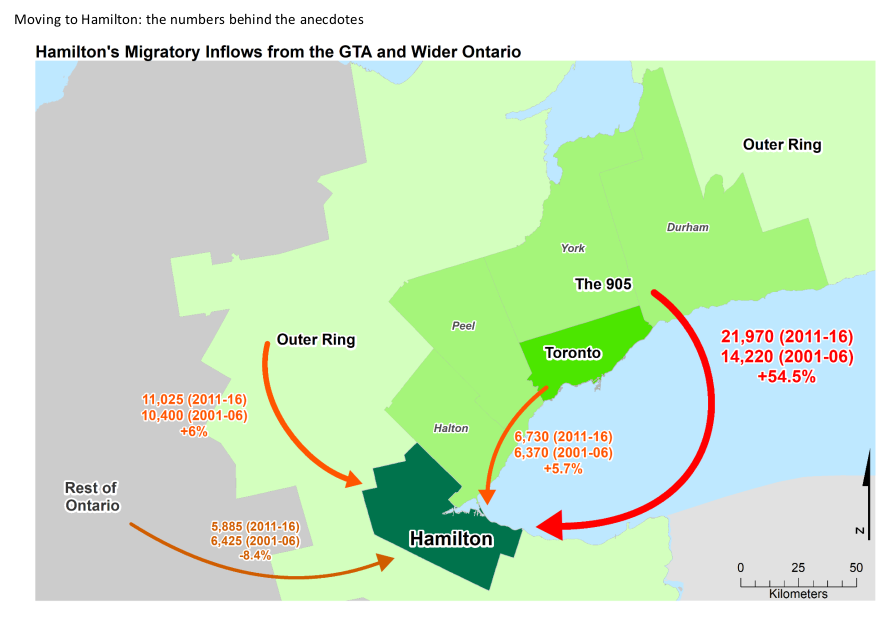An urban studies researcher who set out to answer musings about Torontonians ditching small inner city condos for larger homes and a new life in Hamilton says it’s actually more myth than fact, according to the numbers.

University of Waterloo’s Brian Doucet, a co-author of ‘Moving to Hamilton: the numbers behind the anecdotes’ says the largest source of the migration doesn’t actually come from ‘Hogtown’ but rather from what’s known as the 905 area code, encompassing Halton, Peel, York, and Durham Regions.
The new examination is part of a larger, federally funded four-year probe that started in 2020 looking at changing localities between Toronto and Hamilton.
The latest data touches on the alleged gentrification in Hamilton via newcomers from the Greater Toronto Area (GTA) typically looking for a cost-effective dream or a more spacious environment to live in.
“It gives us a really detailed picture of that Toronto area-to-Hamilton migration,” Doucet told Global News.
“Not only looking at the Toronto region to Hamilton but all the interprovincial migration to Hamilton neighbourhoods.”
Doucet and his colleagues turned to hard data from the 2006 and 2016 Canadian census in a venture to provide empirically-grounded and detailed information on migration patterns.
The authors say the idea of the study is to move beyond anecdotes and provide valuable research to catch the eye of policymakers on city planning who have to mitigate the influx of new residents.
In-migration from the 905 accounts for the largest growth rates between 2001-06 and 2011-16, with the source growing by 54.5 per cent over the two census periods.
Halton and Peel contributed just over 14,000 new residents between 2001 and 2006 and another 22,000 arrivals between 2011 and 2016.
However, there are still migrants coming from the City of Toronto who want to trade one inner city environment for another.
But the overall influx accounted for much lower numbers with just 6,370 and 6,730 checking into the Hammer during the same time frames.
Doucet says “the bigger story” is the actual interpretation of ‘Toronto’ in the ‘Toronto to Hamilton’ anecdote, which really appears to include municipalities like Peel and Halton and not just the city limits.
Alternatively, as the years have gone by, the data also points to southern Ontarians accepting Hamilton as a Toronto-area entity much like Peel and Halton.
“We don’t even speak of the GTA anymore, we speak of the Greater Toronto and Hamilton Area (GTHA),” Doucett remarked.
“These numbers help to illustrate how Hamilton is increasingly a part of that suburban area around the City of Toronto.”
The census tract data also suggests the journey for those coming from Toronto’s suburbs and those coming from Toronto proper are not migrating to the same areas of Hamilton.
Concrete numbers show the amalgamated parts of Hamilton, such as Ancaster, Flamborough, Glanbrook, and Dundas, are the main targets for the new 905 settlers.
The opposite is true for those coming from the 416 area code who predominantly choose the lower city, which is often closer to Hamilton’s core.
“The amalgamated areas of Hamilton have about 39 per cent of the city’s population, but 59 per cent of people moving from the 905 belt around Toronto into Hamilton are moving to those outer suburbs,” said Doucet.
“Only 28 per cent of them are moving to lower Hamilton.”
Most neighbourhoods on the Mountain and in the east end between downtown and Kenilworth near the industrial areas were not prime destinations, according to the migration data.
- Posters promoting ‘Steal From Loblaws Day’ are circulating. How did we get here?
- Canadian food banks are on the brink: ‘This is not a sustainable situation’
- Video shows Ontario police sharing Trudeau’s location with protester, investigation launched
- Solar eclipse eye damage: More than 160 cases reported in Ontario, Quebec
The outer ring of the Greater Golden Horseshoe, which encompasses the Waterloo Region, Guelph, Barrie, Peterborough, Brantford, and Niagara, has also been a larger source of migration to Hamilton than Toronto proper.
Over 10,000 set up shop in Hamilton from those regions between 2001 and 2006 with another 11,000 between 2011 and 2016, according to the study.
Doucet admits the research can’t paint a picture of the financial strength of incoming migrants, but combining census data on average income levels by region and recent area home prices does gives some idea of potential household incomes.
The average lower city household annual income is around $59,468, below the city’s average of $87,775. The cost of a home in central Hamilton as of the end of June was around $650,000, according to the RAHB.
Income in the amalgamated parts is at least $100,000 a year, while homes are priced at over $1 million.
“We can’t conclude anything about the people who moved in, whether or not they are of that high income. We can sort of say these neighborhoods have high incomes,” Doucet said.
The next piece of the four-year Hamilton study will feature the thoughts of residents living along the future LRT route between McMaster University and Eastgate Square.
It’s expected in the fall of 2022.











Comments